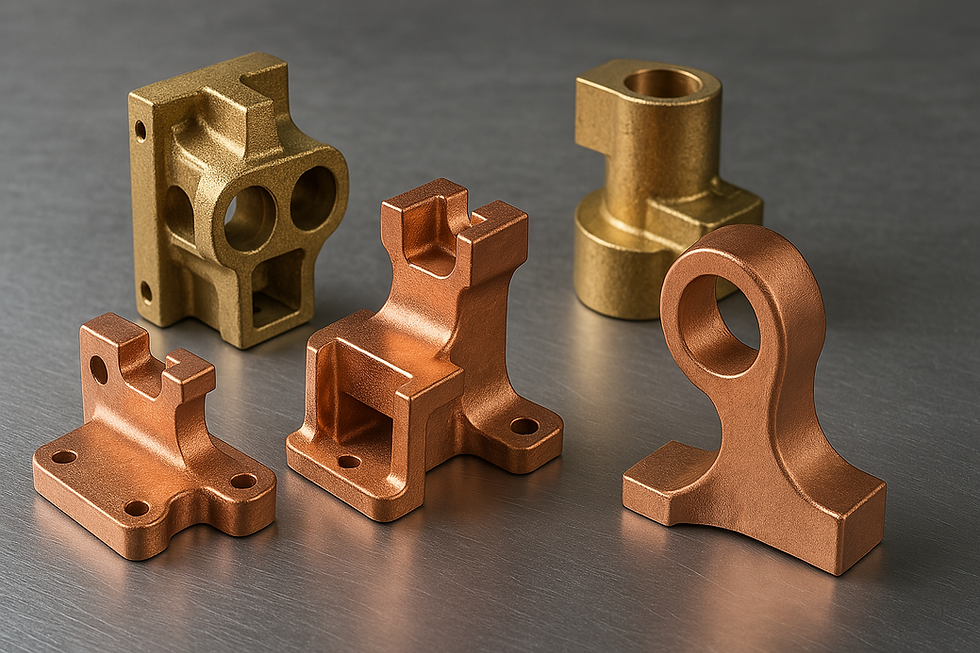Investment Casting of High Conductivity Copper & Brass Parts for High Voltage & Current Electrical Switchgears
- Pahwa MetalTech Pvt Ltd
- Apr 3
- 3 min read

Introduction to Invesment Casting of Copper Alloys
Investment casting is a precision manufacturing process that has been widely adopted for producing complex and high-performance metal components. When it comes to high voltage and high current electrical switchgear, the choice of materials and the method of manufacturing play a critical role in ensuring efficiency, durability, and reliability.
High conductivity copper (HCC) and brass are among the preferred materials for such applications due to their excellent electrical and thermal properties. Investment casting allows for the production of intricate geometries, superior surface finishes, and tightly controlled metallurgical properties, all of which enhance the performance of electrical switchgear components. In this article, we explore how investment casting of HCC and brass parts offers significant advantages in the electrical industry and how these benefits translate to improved switchgear performance.
The Need for High Conductivity Copper and Brass in Electrical Switchgear
Electrical switchgear is essential for power distribution and control in industrial, commercial, and residential settings. These components must withstand high currents, minimize resistive losses, and ensure long-term operational reliability.
High Conductivity Copper (HCC)
HCC, primarily composed of electrolytic tough pitch (ETP) or oxygen-free high conductivity (OFHC) copper, is the material of choice for applications requiring superior electrical conductivity. It offers:
Low electrical resistance: Ensuring minimal energy losses during transmission and switching operations.
High thermal conductivity: Allowing rapid heat dissipation, preventing overheating, and extending component life.
Excellent corrosion resistance: Enhancing longevity, even in harsh environments.
Brass (Copper-Zinc Alloy)
Brass, an alloy of copper and zinc, is used in switchgear applications where mechanical strength, wear resistance, and moderate conductivity are required. It provides:
Good strength-to-weight ratio: Ensuring durability in mechanically stressed components.
Superior machinability: Facilitating efficient and cost-effective production.
Resistance to sparking: Making it suitable for electrical contacts and connectors.
Why Investment Casting for HCC and Brass Switchgear Components?
Investment casting, also known as lost wax casting, is an advanced manufacturing process that produces near-net-shape parts with superior dimensional accuracy and surface finish. For electrical switchgear, investment casting offers several advantages over traditional methods like forging, machining, or sand casting.
1. Complex Geometries with High Precision
Investment casting enables the production of highly intricate designs that would be difficult or impossible to achieve using other methods. Switchgear components often feature:
Internal channels and cooling fins to enhance heat dissipation.
Thin-walled sections to minimize material usage while maintaining conductivity.
Complex contact surfaces for improved electrical connectivity.
By using investment casting, manufacturers can create these features in a single casting, eliminating the need for secondary machining and reducing material waste.
2. Superior Surface Finish
A high-quality surface finish is critical in electrical components to ensure:
Low contact resistance for efficient current flow.
Reduced oxidation and contamination risk.
Improved wear resistance and longevity.
Investment casting inherently produces smooth surfaces with minimal porosity, reducing the need for extensive post-processing. This results in better performance and cost savings.
3. Controlled Metallurgy for Improved Performance
The investment casting process allows for precise control over the chemical composition and grain structure of the cast material. This translates to:
Optimized mechanical properties: Ensuring sufficient strength and ductility for mechanical and electrical loads.
Uniform grain structure: Enhancing conductivity and preventing localized weaknesses.
High purity levels: Reducing impurities that could negatively affect electrical performance.
By carefully selecting and controlling alloy compositions, manufacturers can fine-tune properties to meet specific switchgear requirements.
Applications of Investment Cast HCC and Brass Components in Switchgear
The precision and material benefits of investment casting make it ideal for various switchgear components, including:
1. Busbars and Connectors
Investment cast busbars and electrical connectors ensure minimal resistance and maximum efficiency in power distribution. The ability to produce complex shapes means that optimized current paths can be designed, reducing hotspots and improving longevity.
2. Terminal Blocks and Contacts
Brass terminal blocks and contacts, produced via investment casting, exhibit excellent mechanical strength and wear resistance. The superior surface finish ensures reliable electrical connections and minimal maintenance.
3. Circuit Breaker Components
High conductivity copper circuit breaker components require superior thermal and electrical properties. Investment casting allows for the creation of intricate arc chutes, contacts, and support structures that enhance performance and durability.
4. Heat Sinks and Cooling Elements
Heat dissipation is a key concern in high-power electrical applications. Investment cast copper heat sinks provide efficient thermal management, ensuring stable operation and preventing overheating-related failures.
Investment casting of high conductivity copper and brass parts offers a compelling solution for manufacturing high-voltage, high-current switchgear components. The ability to produce complex geometries with superior surface finish and controlled metallurgy leads to enhanced electrical performance, improved reliability, and cost savings.
As the demand for efficient and high-performance electrical systems continues to grow, investment casting will remain a preferred method for producing precision-engineered components. Pahwa MetalTech, with its expertise in investment casting, is committed to delivering high-quality HCC and brass components tailored to the unique requirements of the electrical industry.
For more information on our investment casting capabilities, contact Pahwa MetalTech at info@pahwametaltech.co.in





Comments